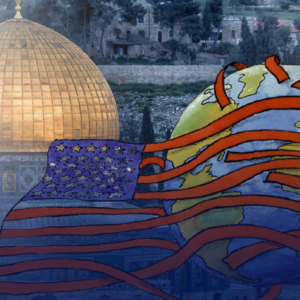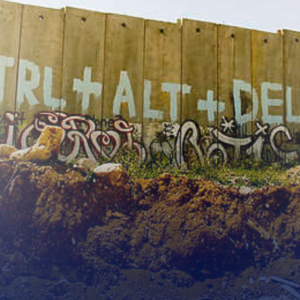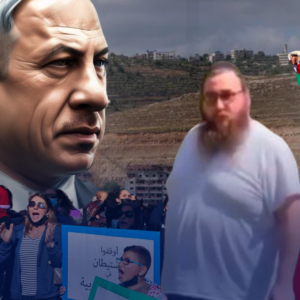All About Palestine V: The First and Second Intifada

All About Palestine V: The First and Second Intifada
Palestine. What was once a thriving, culturally, and religiously diverse land, now lies under the military occupation of a racist, colonial regime. In the early 1900’s, ‘Imperialism’ and ‘Zionism’ merged together in perhaps the greatest conspiracy in human history: to uproot a nation and establish a military outpost in the form of a settler-colony on the shores of West Asia, to serve the British Empire’s interests in the region.

All About Palestine V: The First and Second Intifada
Palestine. What was once a thriving, culturally, and religiously diverse land, now lies under the military occupation of a racist, colonial regime. In the early 1900’s, ‘Imperialism’ and ‘Zionism’ merged together in perhaps the greatest conspiracy in human history: to uproot a nation and establish a military outpost in the form of a settler-colony on the shores of West Asia, to serve the British Empire’s interests in the region.
Written by: Nadia Hojaij and Yahia Hassani | Copy Editors: Zainabrights | Design: Fatima El-Zein
First Intifada 1987-1993
After the 1967 Six-Day War, Israel had occupied the West Bank, East Jerusalem and Gaza, which along with the territory it colonized in 1948, had now usurped the entirety of historic Palestine. In Palestinian-Israeli discourse, many countries, governments, and people, do not recognize the legitimacy of the Zionist State. Meaning, they do not recognize Israel’s right to exist over the lands it colonized in 1948 nor over the lands it occupied in 1967. They consider the entirety of Palestine to be colonized and occupied, and therefore consider the entirety of Israel to be an illegitimate entity composed of illegal settlements. Whereas, the UN and most of the international community, which recognize the legitimacy of the Zionist State, do recognize Israel’s right to exist over the lands it colonized in 1948. However, they do not recognize Israel’s right over the lands it occupied in 1967. They consider only the West Bank, East Jerusalem and Gaza to be illegally occupied, commonly referred to as the Occupied Palestinian Territories (OPT), and therefore consider only the Israeli settlements within these occupied areas to be illegal under international law.
Hardline Zionists do not believe any of Palestine is colonized or occupied because they believe the land is granted to them by God. Zionists continue to expand their illegal settlement activity according to what they believe is their historical Biblical land.
The peace treaty Egypt signed with Israel at Camp David stipulated UN Resolution 242 would be fulfilled, and Israel would completely withdraw from Gaza and the West Bank. However, the Israeli entity ignored the treaty and did not implement it. Instead, Palestinians witnessed an expanding military occupation, intensified land expropriation, and increasing Israeli settlements in the West Bank and Gaza, in total violation of international law. Palestinians suffered continued displacement, home demolitions, wrongful imprisonment, and difficult economic conditions. They were still denied basic human rights including freedom of movement, quality healthcare, education, and the right to self-determination.

By 1987, frustration erupted into the First Intifada, or the first Palestinian uprising. Peaceful demonstrations were largely organized by grassroots and community organizations. They included general strikes, economic boycotts, refusal to pay taxes, and refusal to work on illegal settlements. However, they quickly turned into protests and riots after they were met with violent Israeli reprisals. Young Palestinian men and women confronted the heavily armed occupation with stones, which later became a symbol of the intifada.
Israeli forces adopted the so-called “iron fist” policy of violent repression, using live ammunition against unarmed protestors, jailing demonstrators, imposing punitive curfews and closures, and using brutal force to repress the mostly unarmed popular rebellion. Israeli Defense Minister Yitzhak Rabin implemented the infamous “broken bones” policy, ordering security forces to break the limbs of rock throwers.
This drove Palestinians into more demonstrations, protests, and led to the emergence of Islamic resistance groups, including Hamas which was inspired by the Muslim Brotherhood; and PIJ which was inspired by the Islamic Revolution in Iran.
In 1988, after Jordan renounced all administrative duties in the West Bank, PLO leader Arafat proclaimed a Palestinian State over the West Bank and Gaza, and surprised the world by denouncing resistance, recognizing Israel’s right to exist, and authorizing a land-for-peace process. Israel originally refused. However, in 1992, Labor Party leftist Yitzhak Rabin became Israeli PM and moved forward with the idea, halting settlement expansion after talks with the PLO at the Madrid Conference.
In 1993, after secret negotiations for a potential two-state solution, the Oslo Accords were signed. It called for Israeli withdrawal from Gaza and the West Bank town of Jericho, and the establishment of a Palestinian government that would eventually be granted authority over much of the West Bank. With mixed feelings between different factions on both sides, the historic agreement formally brought the First Intifada to an end. During the uprising, around 150 Israelis and more than 1,200 Palestinians were killed, and tens of thousands of Palestinians injured.
Oslo Years 1993-2000
In exchange for recognizing the Israeli entity as an official state, Oslo I promised Israeli withdrawal from the occupied territories and limited Palestinian self-governance in the form of a Palestinian Authority (PA) which was established by Arafat as he returned from exile. Both sides agreed for the most sensitive issues to be finalized later on, such as Palestinian refugees, defined borders, Jewish settlements, and Jerusalem.

The first stage of Israeli withdrawal from Gaza and Jericho began, transferring authority to the PA which began to assume civil functions. In 1994, Jordan officially recognized the State of Israel, becoming the second Arab country to normalize relations after Egypt in 1978.
In 1995, Oslo II was signed, which detailed the PA election process, prevention of hostilities, redeployment of Israeli forces, and expansion of Palestinian self-rule. It guaranteed the most sensitive issues would be commenced by May 1996 and a permanent resolution by May 1999. During the interim period, Oslo II divided the occupied West Bank into three types of administrative territories; 3% under full PA civil and security control (Area A), 24% under PA civil but joint Israeli-Palestinian security control (Area B), and 73% under full Israeli civil and security control (Area C).
Israeli PM Rabin faced harsh criticism from the conservative Likud Party regarding Oslo II, and was assassinated by a Jewish extremist a few weeks after. He was replaced by Likud member Benjamin Netanyaho, an outspoken critic of Oslo, who broke down the peace process. Netanyahu, a long time opposer of any Palestinian state, compared Rabin and other Oslo architects to European leaders who appeased Hitler in the 1930’s, vowed that he “will use all legitimate means at the disposal of a democratic opposition to stop this foolish process, which endangers the very future of the country.” Israeli settlement expansion resumed at an exponential rate.
Between 1993 and 2000, instead of complete Israeli withdrawal from occupied territories, as stipulated in Oslo, illegal Israeli settlements grew by 52%, with a settler population increase of 117% in Gaza and 46% in the West Bank.

 You will find more infographics at Statista
You will find more infographics at Statista
Meanwhile, 740 Palestinian homes were demolished by Israeli occupation forces. Increasing settlements made it more and more unlikely for Palestinians to ever have an independent state and proved the Zionist project’s intention to colonize the entirety of Palestine. Palestinian frustration and distrust continued to mount, leading to sporadic clashes between resistance groups and Israeli forces. In 1999, new Labor party Israeli PM Ehud Barak pledged to resume Oslo talks with the PLO at a summit in Camp David. However, negotiations failed when Israel demanded the PLO give up Jerusalem and the refugee issue. In 2000, after seven years of fruitless negotiations, tensions erupted into the Second Intifada.
The Second Intifada 2000-2006
After successive Israeli governments failed to abide by the Oslo accords and end the occupation, tensions erupted into the Second Intifada. It was sparked on September 29, 2000 after Likud leader Ariel Sharon made a highly provocative visit to the Temple Mount in occupied East Jerusalem where he stormed the al-Aqsa Mosque compound with more than 1,000 heavily armed police to promote Israeli sovereignty over the site.
Fighting broke out between Palestinians defending the al-Aqsa Mosque and Israeli forces. Protests, demonstrations, and civil disobedience quickly ensued, which eventually spread throughout the West Bank and Gaza. Riots and stone-throwing were brutally repressed by Israeli forces. Tanks and helicopter gunships catapulted rubber bullets and live ammunition on unarmed protesters, firing over 1.3 million rounds in the first month alone. In the first five days, 47 Palestinians were killed and more than 1,880 injured.
The world witnessed the enduring images caught on live television of 12-year-old Muhammad Durrah killed in his fathers lap as they sought shelter from Israeli gunfire. This sparked global outrage due to Israel’s indiscriminate targeting of children.
Senior PLO official Wael Abu Usef believed the use of excessive force proved Israel’s intention to militarize the intifada in order to drag the Palestinians into confrontation stating,
“Israel wanted through Sharon’s visit to provoke the Palestinians into a violent reaction. The Israelis thought that dealing a severe military blow to the Palestinians would lower their political demands in the negotiations in the aftermath of Camp David summit.”
Palestinians continued to organize and protest non-violently against Israel’s military campaign which included increasing settlements, home demolitions, and separation walls, which Israel began building around the West Bank to match the one erected around Gaza in 1996.
Legal advisor and former PLO spokesperson Diana Buttu reported:
“The vast majority of the Second Intifada was non-violent. This was constantly unreported because it didn’t fit into the narrative that was being portrayed to the Western media.”
However, the use of excessive force transferred the mostly non-violent popular resistance into an armed rebellion.
In 2001, newly appointed Israeli PM Sharon began his term by launching several major military operations into the occupied territories, including the first time use of F-16 warplanes on Gaza. Israel executed over 200 targeted assassinations of various Palestinian military and political leaders. Israel bombed and demolished Gaza’s newly built airport only three years after it had opened.
In 2002, the PLO endorsed yet another Peace Initiative, this time brokered by Saudi, which offered full Arab-normalization in return for Israeli withdrawal from all occupied territories in accordance with UN Resolution 242, the right for Palestinian refugees to return, and an independent Palestinian state along the 1967 lines. However, the plan was rejected by Israel and different factions within the Arab camps. Israel objected to the repatriation of Palestinian refugees and a Palestinian capitol in East Jerusalem. Syria opposed the term ‘normalization’, while Hamas and other Palestinian resistance groups could not recognize the Israeli entity as a legitimate state because they believed the entirety of Palestine is rightfully Palestinian.
As the Second Intifada raged on, Palestinians continued with non-violent demonstrations and armed resistance against the Israeli military incursions. Israel used the Palestinian Resistance as a pretext to expand its settler-colonization, entrench its military occupation, escalate its excessive force, and issue demands based on so-called security needs.

Butta reported “They started to make loud demands to take the entirety of the Jordan Valley, taking all of Jerusalem, keeping the settlements there. It later turned into building the wall, it later turned into keeping the checkpoints and army bases inside Palestinian land.”
There was no formal end date to the Second Intifada. As for casualties, the UN reported 1,024 Israelis and 4,228 Palestinians killed between the onset and July 2007, with tens of thousands injured. According to the Palestinian Center for Human Rights, 1,262 of Palestinians killed were children. Israeli forces demolished more than 5,000 Palestinians homes and damaged another 6,500 beyond repair. Nonetheless, the Palestinian resistance had taken a toll on the Israeli occupation forces and the Israeli public. In June 2004, Israel was forced to begin a full withdrawal and evacuation of both troops and settlers from Gaza, which was completed in September 2005. However, Israel remained in control of Gaza’s border, coastline, and airspace.
After Arafat’s death in late 2004, Fatah member Mahmoud Abbas was elected as the new PA chairman and PLO leader. The PA resumed negotiations with Israel. In early 2005, Abbas and Sharon declared a truce at a summit in Egypt, and an informal cease-fire was called.
However, the West Bank remained under military occupation where Israeli settlement activity continued. Meanwhile, Palestinian resistance groups in Gaza refused to normalize relations with Israel, and believed resistance was the only way to freedom and self-determination. Especially after they had just liberated Gaza from Israeli occupation forces, and considering decades of negotiations, peace talks, and UN resolutions proved useless in preventing Israel’s expanding military occupation and increasing settlements.
In 2006, Palestinians held general elections, where the PA’s Fatah party was criticized as corrupt and inefficient thereby, suffering a decisive loss to Hamas. In June 2007, after a coalition government failed, a power struggle ensued which resulted in Fatah remaining limited control of the West Bank, and Hamas taking control of Gaza. For the first time, Palestinians had two separate administrations.
In autumn 2007, Israel imposed a land, air, and sea blockade on the Gaza strip which was in grave violation of international law as it isolated Gaza from the rest of occupied Palestine and the outside world.
Gaza, until today, remains under siege.
The piece you just read is a part of a larger report on Palestine. Each day we will delve into a different aspect.
SOURCES
- What Price Israel, Alfred Lilienthal, Pages 148-150
If you value our journalism…
TMJ News is committed to remaining an independent, reader-funded news platform. A small donation from our valuable readers like you keeps us running so that we can keep our reporting open to all! We’ve launched a fundraising campaign to raise the $10,000 we need to meet our publishing costs this year, and it’d mean the world to us if you’d make a monthly or one-time donation to help. If you value what we publish and agree that our world needs alternative voices like ours in the media, please give what you can today.




